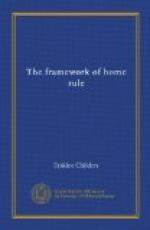3. So far, good. But there still remained a further question far transcending the other in importance—What was to be the relation between the Home Government and the new Colonies? Here all British intellects, that of Fox alone excepted, were as much at a loss as ever. One simple deduction was made from what had happened in America, namely, that the new Colonies must not be forced to contribute to Imperial funds by taxes levied from London. That claim had already been abandoned in 1778 by the Colonial Tax Repeal Act, which nevertheless expressly reserved the King’s right to levy “such duties as it may be expedient to impose for the regulation of commerce,” the sum so raised to be retained for the use of the Colony. No one made the more comprehensive deduction, even in the case of wholly British Upper Canada, that Colonial affairs should be controlled by Colonial opinion, constitutionally ascertained, and that the British Governor should act primarily through advisers chosen by the majority of the people under his rule. We must bear in mind that, had Grattan’s Parliament been reformed, and the warring races in Ireland been brought into harmony, it would still have had to pass through the crucial phase of establishing its right to choose Ministers by whose advice the Lord-Lieutenant should be guided, that is, if it were to become a true Home Rule Parliament of the kind we aim at to-day.
From the date of the Constitutional Act passed for Canada in 1791, it took fifty-six troubled years and an armed rebellion in each Province to establish the principle of what we call “responsible Government” for Canada, and, through Canada, for the rest of the white Colonies of the Empire. During these fifty-six years, which correspond in Irish history to a period dating from the middle of Grattan’s Parliament down to the great Famine, ascendancies, with the symptoms of disease which always attended ascendancies, grew up in Canada, as they had in Ireland, in spite of conditions which were far more favourable in Canada to healthy political growth. Canada started with this great advantage over Ireland, that instead of a corrupt parody of a Parliament, each of her Provinces, under the Constitutional Act of 1791, had a real popular Assembly, elected without regard to race or religion. It was the Upper House or Legislative Council, as it was called, that interposed the first obstacle to the free working of popular institutions. In both Provinces this Council was nominated by the Governor,




